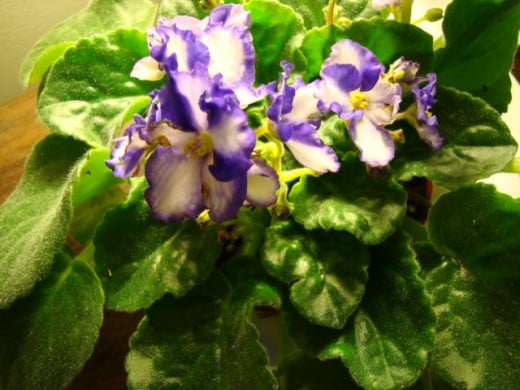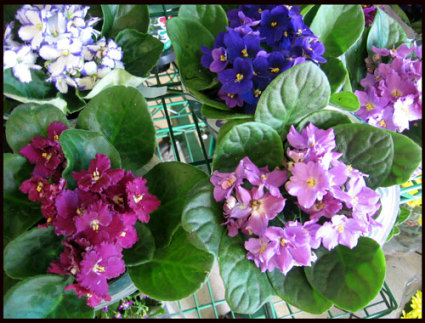- HubPages»
- Home and Garden»
- Gardening»
- House Plants
Caring for Your African Violet Plant
Origins of the African Violet
Caring for your African Violet is a simple task, and will reward you with a flower show all through the year. This is especially uplifting when winter persists and all seems bleak and colourless outside. Its delicate flowers bloom in a variety of colour and it often lends itself well to areas where other houseplants won’t grow because of lesser light.
Discovered in 1892 by the German governor of Tanzania, Baron Walter von Paul, in the Usambara Mountains, the violet, which is not a true violet, soon became a popular European addition to the parlour. In 1926 the plant was brought to California where it has since gained North American favour and has been hybridized into many colours, shapes and sizes.

African Violet Care
Unlike many other house plants African Violets prefer to be in a north window. While some suggest a west or east location I have found them to do particularly well in a northern exposure. Its location can be adjusted with the time of year. With winter’s less intense sun it may even do well near a southern window. The secret is not to expose the plant to direct or hot sun. I have a variegated purple and white violet which survives without any natural light, and in fact grows and flowers under the attention of two Mini Decorative Twister energy saver bulbs, and has for several months.
When watering African Violets be sure not to get any water on the leaves as they are tender and white spots will form. I have discovered the best method is to water from below and allow the water to soak up from the bottom. When the soil on top is slightly dry, water again. The plant needs regular fertilising. Garden stores will have specific fertiliser for the African Violet, but I have had success with an ordinary flowering-plant solution. Some people insist that coffee is a great way to boost the plant’s flowering capabilities if it’s refusing to flower. There are two methods: coffee grounds mixed in with soil, or periodically watering with cool leftover coffee. The plants need a rich soil, but be sure not to pack the soil too tightly when potting. Again, specific soils for the violets are available.
The easiest way to propagate the plant is to take a single leaf, apply rooting hormone to the end of the stem, and plant in a small pot. It may take a few weeks, but soon you will see small leaves forming around its base. This is an inexpensive way to expand your collection and variety.

- PlantCare.com - Indoor House Plants Database
Check out our extensive plant database of outdoor and indoor plants and trees. Thousands of individual house plant guides, pictures, and plant care information in one, easy to use plant care database. - Encyclopedia of House Plants
Encyclopedia of House Plants - African Violets - Growing and Care | Plant-Care.com
The ever-popular African Violet is easy to grow and care for and flower almost all the time

Pests and Disease
Despite being an indoor plant and not usually exposed to the pests and diseases of the garden, your African Violet is susceptible to infection. One of the common pests are thrips which are white to beige coloured bugs about 4 mm large. They can survive on the leaves, but become more evident if the plant is in bloom where they will eat the pollen within the yellow anthers. Your plant will look sickly and once thrips are established they can be difficult to eradicate. The experts advise to remove the flowers and discourage flowering for at least six months.
There are two types of mealy bugs that can attack your plant. Foliar mealy bugs appear as tiny cotton balls near the base of the leaves, and soil mealy bugs can look like grains of rice on the soil. Both will suck the juice from your plant. Foliar bugs can be picked off by hand or wiped away with an alcohol-dipped swab. Insecticides can also be used.
Spider mites are another pest which can kill a plant quickly. The mites are almost invisible and will hide under the leaves where they thrive on the juice of the plant. Good indicators of spider mites are curled and brittle leaves. Many experts will suggest the plant be thrown out, as they can easily infect other plants. I battled with spider mites for half a summer on a balcony where they had attacked petunias in a planter box. While I eventually eradicated them with a spray insecticide, I was left with bare stems and tiny leaves struggling to sprout just before a good frost put them out of their misery.
The most common disease affecting the African Violet is powdery mildew. It resembles white powder sprinkled on the leaves. An application of sulphur should cure it, but there are commercial chemical treatments available as well. Generally, pest and disease infestations are rare. Simple precautions will prevent them. When you bring a new plant into the house be sure to isolate it from your collection for several weeks. Do not introduce outside plants indoors. This includes cut flowers. While fresh flowers from your garden are nice to have to liven up a table they can transport nasty experiences to your violets.
There are many ways to display the little plants. Balcony planters brought in for the winter can double as a great way to group several different violets together. It will give the illusion of indoor summer while winter blasts away. Basket arrangements or terrariums are interesting ways to show off violets in bloom. Wherever you place them, they will bring countless hours of enjoyment through their colour and unique texture.
Works Consulted
1) Jim T., specieshistory.PDF, African Violet Society of Canada, 2002.
2) Pests and Diseases, avsc.ca/pestsdiseases.htm, Jan. 13, 2010.









